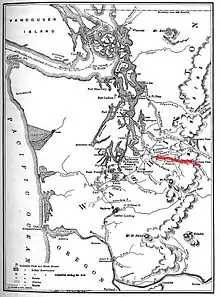Naches Trail
Naches Trail (also spelled Nachess) is a historic trail in the U.S. state of Washington. It extends from the Naches River in Eastern Washington in the area inhabited by across Naches Pass in the Cascade Mountains to the Greenwater River in present-day Pierce County in Western Washington. Originally a trail used by the indigenous Yakama people in the east and Salish people in the west, it became one of the main routes of immigration by settlers to the Puget Sound region in the 19th century, especially before the improvement of the lower Snoqualmie Pass, which became the route of U.S. Route 10 then Interstate 90. The first written documentation of a traversal of the pass was made by a member of the United States Navy Wilkes Expedition, Lieutenant Robert E. Johnson in 1841.[1] Due to dense forest on the west side of the pass, construction of a road was initially considered infeasible in 1853. The Longmire Party crossed the pass with their wagons, having to let them down the Naches Trail Cliffs (47.10419°N 121.46894°W) with ropes.[2]

The road was never paved. As of 2017, it contains United States Forest Service forest roads popular for off-roading.[3][4] The road has been proposed as a new state highway, designated as Washington State Route 168, since the 1930s.[5]
References
- Lieutenant Robert E. Johnson, U.S.N. (1916), "First Recorded Trip Through Naches Pass, 1841", in Edmond S. Meany (ed.), Mount Rainier: A Record of Exploration, Macmillan, pp. 13–33 – via Project Gutenberg
- John Caldbick (January 20, 2014), Pioneer David Longmire buys homestead in Wenas Valley, Yakima County, on March 10, 1871., HistoryLink
- Naches Trail 1175, United States Forest Service
- "Epic off-roading: Washington's 4 top trails", The Seattle Times, August 1, 2016
- "Governor's Budget Ignores the White Pass Route", The Chehalis Bee-Nugget, January 23, 1931, retrieved June 3, 2017
External links
- Naches Trail information from Bonney Lake Historical Society
- Naches Trail site, Oregon-California Trails Association
- U.S. Geological Survey Geographic Names Information System: Naches Pass-Greenwater Trail